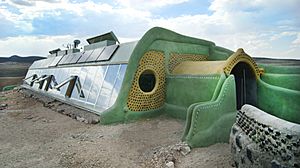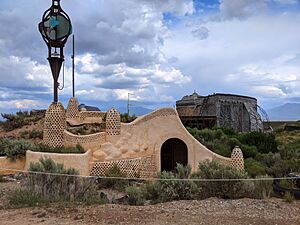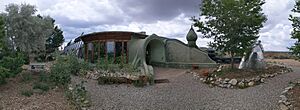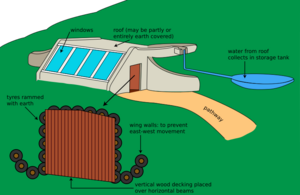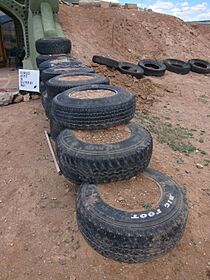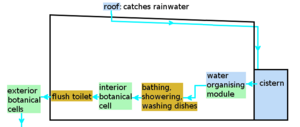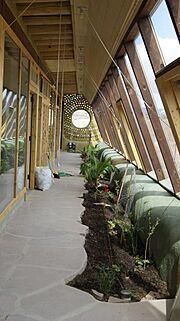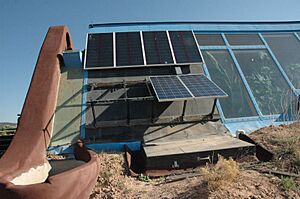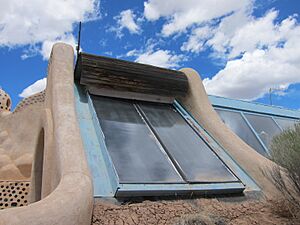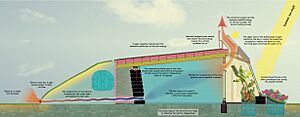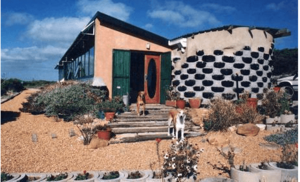Earthship facts for kids
Imagine a house that builds itself using recycled items and natural resources! An Earthship is a special kind of building. It was created by architect Michael Reynolds in the late 1900s and early 2000s. These homes are designed to be very eco-friendly.
Earthships use materials like old tires packed with earth. They also use natural sunlight to stay warm. These unique houses can keep a comfortable temperature inside, around 70°F (21°C), even when it's very hot or cold outside. The first Earthship communities were built in the deserts of New Mexico. Now, you can find them in many places around the world.
Michael Reynolds wanted to build homes that didn't rely much on city power or fuel. Earthships use energy from the sun and collect rainwater. They are built to keep a steady temperature naturally. Their designs are often simple, so many people can help build them. Earthships are a great example of living sustainably and being self-sufficient.
Contents
How Earthships Began
The idea for Earthships started in the 1970s. Architect Michael Reynolds had a big dream. He wanted to create homes that met three important goals.
First, these homes would use materials that were good for the planet. They would use things found nearby or recycled items. Second, they would get all their energy from nature. This meant they wouldn't need to connect to the main power grid. Third, anyone, even without special building skills, could help build them. Over time, this dream led to the U-shaped homes made from earth-filled tires we see today.
The name "Earthship" comes from the idea of a ship or a spaceship. Just like a ship carries everything its crew needs, an Earthship provides for its residents. It offers shelter, power, water, and even helps manage waste and grow food.
Building an Earthship: Key Ideas
Earthships are built using six main ideas. These ideas help make the homes friendly to our planet.
Smart Design Principles
- Using Natural and Recycled Materials: Earthships are built with things like old tires, cans, bottles, wood, and mud. This helps reduce waste.
- Heating and Cooling with the Sun: These homes use sunlight and thick walls to stay warm or cool. They don't need electricity or fuel for temperature control.
- Making Your Own Electricity: Solar panels and sometimes windmills create electricity. Earthships also use energy-saving lights and appliances to use less power.
- Collecting Rainwater: Rain and melted snow are collected from the roof. This water is stored in a tank for later use.
- Recycling Used Water: Earthships have systems to clean and reuse water from sinks and showers.
- Growing Food Inside: Many Earthships can grow fruits and vegetables right inside the house!
How They Are Built
Earthships often have a horseshoe shape. This is because it's easier to build curved walls with packed tires than sharp corners. The open part of the horseshoe usually faces south. This helps the house get the most sunlight and warmth in winter. Large windows on these sunny walls let in light and heat.
The thick, dense walls are key to keeping the inside temperature steady. Most outer walls are made from old tires packed tightly with earth. Other heavy materials like concrete, adobe, or stone can also be used. These tire walls are stacked like bricks. Sometimes, smaller "squishy" tires are used to fill gaps.
Building with earth-packed tires is a team effort. Two people work together: one shovels dirt into the tire, and the other uses a sledgehammer to pack it down. A single packed tire can weigh up to 300 pounds (136 kg)! Because they are full of soil, these tire walls don't burn easily. In colder places, extra insulation is added to the outside of the tire walls.
Above the tire walls, builders use "bond beams." These can be made from recycled cans held together with concrete, or from wood. These beams help hold the roof. Inside, walls that don't hold up the roof are often made from a honeycomb pattern of recycled cans and concrete. These "tin can walls" are then covered with adobe plaster, making them look like traditional mud walls.
The roof is supported by wooden beams. Both the roof and the north, east, and west walls have lots of insulation. This helps prevent heat from escaping.
Water Systems in Earthships
Earthships are amazing at collecting and reusing water. They are designed to gather all the water they need from their surroundings.
Collecting Rainwater
Water comes from rain, snow, and even moisture in the air. When rain falls on the roof, it flows into a special tank called a cistern. This tank stores the water. From the cistern, the water goes through a filter system. This system cleans the water, making it safe to drink and use for washing. A pump then sends this clean water to faucets and showers, just like in a regular house.
Reusing Greywater
Water from sinks and showers is called "greywater." This water isn't clean enough to drink, but it's perfect for other uses. Earthships send greywater through a special filter. Then, it flows into an indoor garden area called a botanical cell. Plants and helpful bacteria in this cell naturally clean the greywater. After this natural cleaning, the water is collected and used to flush toilets. This way, water is used more than once!
Handling Blackwater Safely
Water from toilets is called "blackwater." Earthships have a safe way to deal with this too. They use special tanks where natural processes break down waste. This treated blackwater is then used to water non-food plants in outdoor gardens or separate plant cells. This helps keep the environment clean and uses every drop of water wisely.
Powering an Earthship
Earthships are built to create and store their own electricity. Most of their power comes from clean, natural sources.
Solar panels on the roof capture energy from the sun. Sometimes, wind turbines also help generate power. This electricity is stored in special batteries. These batteries are usually kept in a safe room on the roof. If needed, some Earthships can also connect to the city power grid or use small generators.
A special system called a Power Organizing Module (POM) manages the electricity. It takes power from the batteries and makes it ready for your home appliances. This module has all the necessary parts, like safety switches. You can use this power for washing machines, computers, kitchen gadgets, and more. The best part is that Earthships don't use this electricity for heating or cooling, saving even more energy!
Keeping the Temperature Just Right
Earthships are designed to stay comfortable inside, no matter the weather outside.
How Earthships Stay Warm and Cool
These homes use thick walls made of packed tires and earth. These walls soak up heat from the sun during the day. Then, they slowly release that heat at night, keeping the house warm. This is called "thermal mass." Some Earthships are even built partly underground. This helps them use the earth's natural temperature to stay steady.
Earthships also use "passive solar heating and cooling." This means they use the sun's energy without needing machines. Large windows on the sunny side let in light and warmth. These windows are angled to get lots of sun in winter when heat is needed. In summer, when it's hot, the angle helps block direct sun. Some Earthships have a "double greenhouse" area. This space grows food and creates an extra layer of insulation for the living areas.
Fresh Air Inside
Earthships have a natural way to keep fresh air moving. A long pipe brings cool air from outside, under the ground, into the house. As warm air inside rises, it flows out through a small vent. This creates a constant flow of cool, fresh air without using electricity.
Earthships Around the World
Earthship designs started in New Mexico, USA, but they have spread globally. People in many countries have built or are building these unique homes.
Earthships in Africa
The first Earthship in South Africa was built between 1996 and 1998. It used 1,500 rammed tires for its walls. Another Earthship in South Africa is a recycling center. In Sierra Leone, the Goderich Waldorf School became the first school to use Earthship architecture. Community members helped build it after learning the techniques. Projects have also taken place in Malawi and Eswatini.
Earthships in Australia
Earthship Ironbank was the first Earthship in Australia to get official permission from the local council. It was built near Adelaide in South Australia.
Earthships in Europe
In the early 2000s, Michael Reynolds and his team started building Earthships in Europe. The first one in the UK opened in 2004 in Scotland. In 2005, the first Earthship in England was built in Stanmer Park, Brighton. The first official Earthship home in mainland Europe with full planning permission was built in a French village called Ger in 2007.
Earthships have been built or are being built in many European countries. These include Portugal, Spain, France, Belgium, The Netherlands, the United Kingdom, Sweden, Denmark, Germany, Estonia, and the Czech Republic. In Olst, Netherlands, a whole district of 23 Earthships was completed in 2014. Some European Earthships have been adapted to suit cooler, wetter climates.
Earthships in Central and South America
An Earthship was built in southern Belize in 2015. Guatemala also has two Earthships.
The first Earthship in South America was built in January 2014 in Ushuaia, Argentina. It now serves as a visitor center. In 2016, an Earthship school was built in Uruguay, and another in Argentina in 2018.
Earthships in New Zealand
An Earthship was built near Ashburton, Canterbury, by Dawn and Lance Kirtlan. They worked with local experts and received support from their local council.
See also
 In Spanish: Earthship para niños
In Spanish: Earthship para niños
- Buildings that can withstand hurricanes
- Designing sustainable living systems
- Finding new uses for old items
- Using the sun's heat for energy


